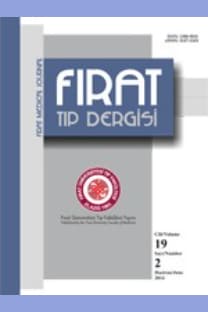Negatif Basınçlı Terapinin Diyabetik Hastalardaki Ayak Dorsumu Defektlerini Deri Grefti Rekonstrüksiyonuna Uygun Hale Getirmesi
Negative Pressure Therapy Makes Diabetic Foot Dorsum Defects Suitable for Skin Graft Reconstruction
___
- 1. Schrauwen P, van Marken Lichtenbelt WD. Com- batting type 2 diabetes by turning up the heat. Dia- betologia 2016; 59: 226979.
- 2. Tchero H, Herlin C, Bekara F, Kangambega P, Sergiu F, Teot L. Failure rates of artificial dermiş products in treatment of diabetic foot ulcer: A sys- tematic review and network meta-analysis. Wound Repair Regen 2017; 25: 691-6.
- 3. Wang R, Feng Y, Di B. Comparisons of negative pressure wound therapy and ultrasonic debride- ment for diabetic footulcers: a network meta- analysis. Int J Clin Exp Med 2015; 8: 12548-56.
- 4. Cavanagh PR, Bus SA. Off-loading the diabetic foot for ulcer prevention and healing. Plast Re- constr Surg 2011; 127: 248S-56S.
- 5. Neville RF, Kayssi A, Buescher T, Stempel MS. The diabetic foot. Curr Probl Surg 2016; 53: 408- 37.
- 6. Herscovici D Jr, Sanders RW, Scaduto JM, Infante A, DiPasquale T. Vacuum-assisted wound closure (VAC therapy) for the management of patients with high-energy soft tissue injuries. J Orthop Tra- uma 2003; 17: 683-8.
- 7. Bovill E, Banwell PE, Teot L et al. Topical negati- ve pressure wound therapy: a review of its role and guidelines for its use in the management of acute wounds. Int Wound J 2008; 5: 511-29.
- 8. DeFranzo AJ, Argenta LC, Marks MW et al. The use of vacuum-assisted closure therapy for the tre- atment of lower-extremity wounds with exposed bone. Plast Reconstr Surg 2001; 108: 1184-91.
- 9. Lin TS, Quing R. Long-term results of a one-stage secondary debulking procedure after flap reconst- ruction of the foot. Plast Reconstr Surg 2016; 138: 923-30.
- 10. Gross CE, Garcia R, Adams SB, DeOrio JK, Eas- ley ME, Nunley JA 2nd. Soft tissue reconstruction after total ankle arthroplasty. Foot Ankle Int 2016; 37: 522-7.
- 11. Hong JP. Reconstruction of the diabetic foot using anterolateral thigh perforator flap. Plast Reconstr Surg 2006; 117: 1599-608.
- 12. Argenta LC, Morykwas MJ. Vacuum-assisted closure: a new method for wound control and tre- atment. Clinical experience. Ann Plast Surg 1997; 38: 563-76.
- 13. Novak A, Khan WS, Palmer J. The evidence-based principles of negative pressure wound therapy in trauma & orthopedics. Open Orthop J 2014; 27: 168-77.
- 14. Mooney JF III, Argenta LC, Marks MW, Morykwas MJ, DeFranzo AJ. Treatment of soft tissue defects in pediatric patients using the V.A.C. system. Clin Orthop Relat Res 2000; 376: 26-31
- 15. Joseph E, Hamori CA, Bergman S, Roaf E, Swann NF, Anastasi GW. A prospective randomized trial of vacuum-assisted closure versus standard therapy of chronic nonhealing wounds. Wounds: A Com- pendium of Clinical Research and Practice 2000; 12: 60-7.
- 16. Mullner T, Mrkonjic L, Kwasny O, Vecsei V. The use of negative pressure to promote the healing of tissue defects: a clinical trial using the vacuum sealing technique. Br J Plast Surg 1997; 50: 194-9.
- 17. Lang E, Bauer G, Becker U, Bischoff M. The vacuum sealing technique in the treatment of foot and ankle trauma with severe soft-tissue damage. Aktuelle Traumatol 1997; 27: 223-7.
- 18. Krasner DL. Managing wound pain in patients with vacuum-assisted closure devices. Ostomy Wound Manage 2002; 48: 38-43.
- 19. White RA, Miki RA, Kazmier P, Anglen JO. Va- cuum-assisted closure complicated by erosion and hemorrhage of the anterior tibial artery. J Orthop Trauma 2005; 19: 56-9.
- 20. Fuchs U, Zittermann A, Stuettgen B, Groening A, Minami K, Koerfer R. Clinical outcome of patients with deep sternal wound infection managed by va- cuum-assisted closure compared to conventional therapy with open packing: a retrospective analy- sis. Ann Thorac Surg 2005; 79: 526-31.
- ISSN: 1300-9818
- Yayın Aralığı: 4
- Başlangıç: 2015
- Yayıncı: Fırat Üniversitesi Tıp Fakültesi
Meme Karsinomunda VEGF ve CD44 Ekspresyonunun Aksiller Lenf Nodu Metastazına Etkisi
Muhammet ÇALIK, İlknur ÇALIK, Betül GÜNDOĞDU, Sare ŞİPAL
Ciddi Komplikasyonlara Yol Açabilecek Bir Sendrom: Saç Turnike Sendromu
Aplazia Kutis Konjenita Tip VI (Bart Sendromu) Olgusu
Hatice TURGUT, Hüseyin KAYA, İsmail Kürşad GÖKÇE, Ramazan ÖZDEMİR, Ercan YILMAZ, Lale GULİYEVA
Tıp Fakültesi Öğrencilerinin Toplumsal Cinsiyet Rollerine Yönelik Tutumları ve Etkileyen Faktörler
Ahmet ERGİN, Türker BEKAR, Güliz AYDEMİR ACAR
İrem TAŞCI, Caner Feyzi DEMİR, Zeynal TUNÇ
Travma Hastalarında Skapula Kırıklarına Eşlik Eden Toraks Yaralanmalarının Değerlendirilmesi
Muharrem ÇAKMAK, Yeliz GÜL, Mehmet Çağrı GÖKTEKİN, Evrim GÜL
Ata Türker ARIKÖK, Evrim ÖNDER, Binnur ÖNAL, Engin Deniz YILMAZ
Stres Üriner İnkontinans Tedavisinde Tek İnsizyon Midüretral Sling Yönteminin Klinik Etkinliği
Ahmet KARAKEÇİ, Necip PİRİNÇÇİ, Fatih FIRDOLAŞ
Yoğun Bakım Ünitesinde Takip Edilen Zehirlenme Olgularının Değerlendirilmesi: Retrospektif Çalışma
Panik Bozukluğu olan Hastalarda Kaudat Çekirdek Hacimleri ve Klinik Değişkenlerle İlişkisi
Murad ATMACA, Mehmet Gürkan GÜROK, Faruk KILIÇ, Hanefi YILDIRIM
